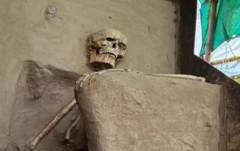The skeleton, which was found in a meditative position by archaeologist Abhijit Ambekar in 2019, has yet to find a permanent home due to disputes between the Archaeology Survey of India (ASI) and Gujarat officials. The well-preserved remains, believed to date back to the Solanki dynasty (940-1300 CE), are currently housed in makeshift shelter, leaving them exposed to the elements and unguarded.
Ambekar notes that other artifacts from Vadnagar were placed in local museums, but due to bureaucratic inertia, the skeleton remains at risk. “It's a valuable find that can better inform us about our historical lifestyle,” he explains. Furthermore, the lack of clarity over responsibility has hindered progress towards a museum display, even with the new Archaeological Experiential Museum nearby, which does not contain the actual remains.
Locals express frustration over the delays, highlighting that the skeleton could attract global interest and tourism to Vadnagar, the birthplace of Prime Minister Narendra Modi. “The treatment of such a unique antiquity is unsettling,” shares resident Jesang Thakor. Although authorities pledge to move the skeleton soon, further studies are needed to ascertain more about the individual, including their diet and lifestyle.
The skeleton remains a poignant reminder of Vadnagar’s rich past, yet its continued absence in formal display raises pressing questions about preservation and attention to historical significance. As officials move to resolve the situation, many hope for a swift resolution before this piece of history is left “for dead” again.
Ambekar notes that other artifacts from Vadnagar were placed in local museums, but due to bureaucratic inertia, the skeleton remains at risk. “It's a valuable find that can better inform us about our historical lifestyle,” he explains. Furthermore, the lack of clarity over responsibility has hindered progress towards a museum display, even with the new Archaeological Experiential Museum nearby, which does not contain the actual remains.
Locals express frustration over the delays, highlighting that the skeleton could attract global interest and tourism to Vadnagar, the birthplace of Prime Minister Narendra Modi. “The treatment of such a unique antiquity is unsettling,” shares resident Jesang Thakor. Although authorities pledge to move the skeleton soon, further studies are needed to ascertain more about the individual, including their diet and lifestyle.
The skeleton remains a poignant reminder of Vadnagar’s rich past, yet its continued absence in formal display raises pressing questions about preservation and attention to historical significance. As officials move to resolve the situation, many hope for a swift resolution before this piece of history is left “for dead” again.




















